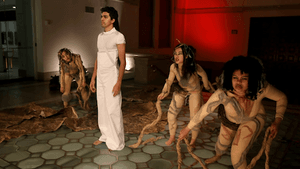Stay in the Loop
BSR publishes on a weekly schedule, with an email newsletter every Wednesday and Thursday morning. There’s no paywall, and subscribing is always free.
Some justice some peace
Philly Fringe 2016 review: 'The Eumenides'

The Eumenides is a profound and problematic play. The third in the trilogy called the Oresteia written 3000 years ago by Aeschylus, it’s a courageous Fringe entry.
Difficult under any circumstances, it’s even more so when student actors take on these enormous classical roles. This production is a collaboration between director Marcia Ferguson of the University of Pennsylvania Theatre Arts program and the White Box Theatre, currently in residence at Penn. The choice of location — Penn Museum of Archaeology and Anthropology was a stroke of genius, despite some challenging acoustics.
Location, location, location
As the plot heats up — the stakes are nothing less than the formation of the justice system of Western civilization — the audience travels from room to room in a building that might be even more wondrous than its contents. The first scene takes place in a room without much character. We then move to an enormous domed hall filled with Chinese stone dragons that cast gigantic shadows. For the finale, we enter the Egyptian mummies’s room, and the action takes place among the sarcophagi.
In the two plays preceding this one, Agamemnon has returned from the Trojan War. His victory has depended in large part on the sacrifice of his daughter. His wife, Clytemnestra, murders him, in part as revenge for her daughter’s death. Orestes (Ryan Berlin), their son, returns home after years in exile, and murders Clytemnestra in retribution for killing his father. But while Apollo (Jonathan D’Rorazio), has required this matricide, such an enormous deed cannot be ignored.
My skimpy plot summary brings us to The Eumenides, where Orestes has been hounded across the world by the loathesome Furies, underworld creatures who are the Daughters of Mother Night. That they are manifestations of Orestes’s guilt almost goes without saying, but the mythic story must run its course.
Questions for the ages
When Athena (Grayce Hoffman) appoints the audience as jury (thus establishing the democratic tradition in this, the first murder trial), we are divided: punish or forgive. Athena must break the tie, and in what will establish patriarchal tradition, sides with forgiveness, arguing that women are merely the incubators of life, not the sowers of the seed, and thus a father’s murder is more grievous than a mother’s murder.
It’s a problematic argument, indeed. In the sociopolitical issues department, it’s worth noting that Athena, the powerful goddess of wisdom who runs the whole earthly show, is played by an actor who is blonde and white, while the Furies, whose rage is assuaged so they can become the Eumenides, are played by women of color. Their roles are the largest and the most dramatic (Connie Kang is the production’s standout).
The costumes are odd but effective; most remarkable are the use of cothurnes, the platform shoes worn by actors in ancient Greek drama to give the gods stature. It’s not often you get to see this play, and it still works as a moral dilemma. Is justice served by punishment or forgiveness? We haven’t yet reached an answer.
What, When, Where
The Eumenides. Sept. 10, 2016 at the Penn Museum of Archaeology and Anthropology, 3260 South St., Philadelphia. (215) 413-1318 or fringearts.com.
Sign up for our newsletter
All of the week's new articles, all in one place. Sign up for the free weekly BSR newsletters, and don't miss a conversation.
 Toby Zinman
Toby Zinman